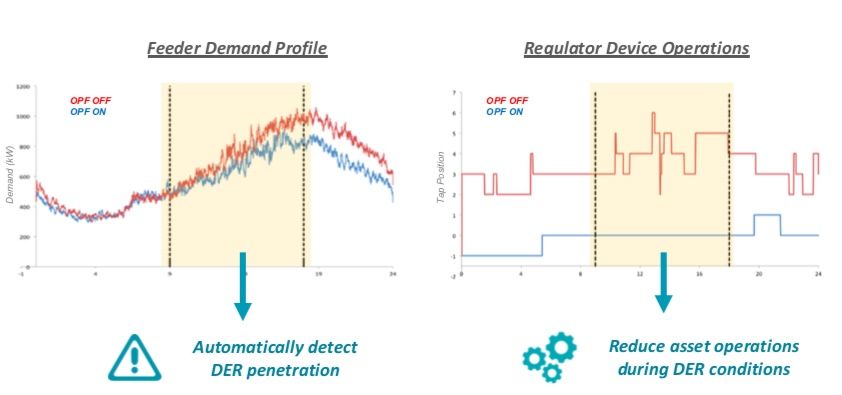Utilidata, Long-Time Grid Voltage Specialist, Sets Its Sights on Grid Edge Controls
Greentech Media
JEFF ST. JOHN
FEBRUARY 19, 2019

Utilidata is using its grid voltage tech to manage solar and other DERs.
Over the past decade, Utilidata has been taking the energy-saving technology known as conservation voltage reduction deeper and deeper into the power grid, with an unusual combination of real-time power flow modeling and real-time grid controls that has allowed greater visibility and insight into the edges of distribution networks.
Now the company is starting to apply its technology to what’s expected to be utilities’ biggest challenge over the coming decade: integrating rooftop solar systems, behind-the-meter batteries, electric car chargers and other distributed energy resources (DERs) at massive scale.
Over the past few years, Providence, Rhode Island-based Utilidata has been expanding its scope of work to include a lot more than conservation voltage reduction. It's taken on voltage balancing on solar-saturated circuits and analyzed grid data to detect areas with high solar or electric vehicle penetration. It's teamed up with industry partners like Siemens on microgrid control systems and with Itron and Landis+Gyr to embed its technology in their latest smart meters and grid networking nodes.
Utilidata’s core conservation voltage reduction technology has already allowed utilities to boost efficiency gains from the 1 to 3 percent typically achieved by traditional CVR schemes to closer to 4 to 5 percent — an up to 50 percent improvement. Such gains have led utility customers like AEP and National Grid to expand the scope of their work with the company in the years since.
“Driving a couple of percentage points [of] savings right off the bat is huge” given the size of the utilities involved, Jess Melanson, Utilidata’s chief operations officer, said in an interview last week.
At the same time, this work has also opened up opportunities for Utilidata and its utility customers to experiment with using the technology not just for saving energy but also for managing DERs, he said.
For example, Utilidata has successfully executed CVR on distribution circuits that are heavily loaded with solar, Melanson said. Traditional CVR technology might struggle to adapt its large-scale voltage regulation devices to manage solar's intermittent output and the resulting voltage fluctuations, he said.
Utilidata’s system, by contrast, can reconfigure circuit voltage controls based on real-time feedback, helping to even out voltages across the circuit while reducing wear and tear on grid voltage regulation equipment.

Solving DER challenges
Solar-heavy distribution circuits are a key DER challenge that utilities are struggling to manage, given their lack of sensors and controls on low-voltage networks. GTM has been tracking different methods of managing these PV-driven grid disruptions, from installing next-generation power electronics on their distribution grids to tapping the flexibility of smart solar inverters or behind-the-meter loads.
Utilidata’s approach now incorporates grid-side devices such as line tap changers, voltage regulators and capacitor banks, with more than a decade of real-world experience in operating the effectively, Melanson said. On the behind-the-meter side, it’s competing with other vendors to win a pilot project with National Grid, seeking to test smart inverter controls on a distribution circuit in Clifton Park, New York.
“We’re already doing CVR on that circuit,” he said. If Utilidata wins the contract, the company is "just going to integrate with some solar farms on the system and apply our technology to some new applications.”
Beyond device controls, Utilidata also brings an overarching awareness of what’s happening on the grid circuits it’s connected to, based on subsecond data it collects and analyzes on the fly. This is something of a holy grail for distribution operators, and versions of this fundamental concept are being offered by the latest advanced distribution management system platforms from grid giants like Siemens, GE and Schneider Electric, as well as by startups such as Smarter Grid Solutions and Opus One.
Next-generation smart meters
Traditionally, Utilidata has relied on its own purpose-built sensors to collect the data its system needs. But in the future, the same capabilities could come from the next generation of smart meters being deployed by some of the world’s biggest advanced metering infrastructure vendors, Melanson noted.
In 2018, Utilidata became the first company to offer its technology as an “app” on Itron's OpenWay Riva IOT platform, embedding its capabilities in new smart meters and communications nodes. Last year it launched a partnership with Landis+Gyr, aimed at tapping the advanced sensoring and data analysis capabilities of the metering giant’s Revelo platform, the next-generation technology it will roll out over the next two years.
State regulators are putting utilities under increasing pressure to expand their deployment plans for advanced metering infrastructure to increase customer benefits. These pressures may convince more utilities to ask for smart meter networks that can support CVR as well as more advanced DER management capabilities, and Utilidata is prepared to meet those requests, Melanson said.
Utilities are loath to trust their day-to-day grid operations to untested technologies, which means that most of these advanced capabilities are still in the pilot project stage. In that light, Utilidata’s years of actively controlling devices and analyzing data in the field could give it an advantage against companies that have only done one or the other, he said.
That same decade-long record of operations data has helped Utilidata develop its anomaly-detection technology, which can differentiate between grid problems such as equipment failure, possible cyber-intrusion into control systems, or power lines coming into contact with tree limbs, Melanson said.
“When we try to figure out what an optimal power flow is or what an anomalous condition is, it’s enormously helpful that our operators and systems have been watching these distribution systems for decades now."
